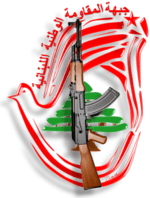Lebanese National Resistance Front
| Lebanese National Resistance Front | |
|---|---|
| Participant in Lebanese Civil War | |
|
Lebanese National Resistance Front logo (1982–2000). | |
| Active | 1982–1999 |
| Groups |
Arab Socialist Action Party – Lebanon Arab Democratic Party |
| Leaders |
George Hawi Muhsin Ibrahim Hussein Hamdan Elias Atallah Inaam Raad Abdallah Saadeh |
| Headquarters |
Beirut Kfar Rumman |
| Strength | 1,000–2,000 fighters |
| Allies |
|
| Opponents |
|
The Lebanese National Resistance Front – LNRF (Arabic: جبهة المقاومة الوطنية اللبنانية, transliterated: Jabhat al-Muqawama al-Wataniyya al-Lubnaniyya) or Front National de la Résistance Libanaise (FNRL) in French, but best known by its Arabic acronym, ‘Jammoul’ (جمول), was an underground guerrilla alliance active in Lebanon in the 1980s. It acted as a successor to the Lebanese National Movement.
Origins
This organization was founded on September 16, 1982, the same day the Israeli army entered West Beirut.[1] The secretary general of the central committee of the Lebanese Communist Party (LCP) George Hawi, the secretary general of the Organization of Communist Action – Lebanon (OCAL) Muhsin Ibrahim, the Arab Socialist Action Party – Lebanon (ASAP-L) secretary general Hussein Hamdan, the Arab Socialist Ba'ath Party – Lebanon Region, and the Syrian Social Nationalist Party (SSNP) issued that day a joint communiqué calling for the Lebanese people to raise up in arms and unite into a "Lebanese National Resistance Front" against Israel.
The pro-Syrian Arab Democratic Party (ADP) and the Lebanese Armed Revolutionary Factions (LARF) soon rallied to the LNRF banner, which gained full support of Palestine Liberation Organization (PLO) leftist and Marxist factions based in Lebanon, mainly from the Popular Front for the Liberation of Palestine (PFLP) and the Democratic Front for the Liberation of Palestine (DFLP).
Structure and organization
The LNRF did not have the strength of other larger militant groups in Lebanon, but by all accounts, it was a highly effective force, being estimated at some 200–500 or so fighters drawn from the LCP, OCAL, LABP, ADP, LARF, PFLP and DFLP, placed under the overall command of Elias Atallah. A joint operational HQ was established at the village of Kfar Rumman in the Jabal Amel region of southern Lebanon, with Hawi and Ibrahim meeting daily in secret to coordinate the activities of the Front's underground cells at west Beirut, Sidon, Tyre and Nabatiyeh in southern Lebanon.
Most observers believe that the Front was a pro-Syrian organization whose membership was primarily Lebanese. However, the PLO stated that the actions claimed by the LNRF were actually carried out by isolated Palestinian guerrilla cells and some radical Lebanese leftists who supported them.
Activities: 1982–85
The LNRF carried out 128 guerrilla attacks against the IDF and Israeli-related targets in Beirut, Mount Lebanon and the South in June, July and August 1983. At this point it was known as the Lebanese National Salvation Front and was backed by Syria.
Decline and demise: 1986–2000
A considerable number of LNRF fighters were killed in combat while fighting Israeli and South Lebanese Army (SLA) troops, whereas militants such as Anwar Yassin and Soha Bechara were taken prisoner and held in the infamous Khiam detention center. Several others were liquidated in assassinations against leftist activists in Beirut and southern Lebanon in the late 1980s.
The last recorded Jammoul operation in the south occurred on 1999.
Notes
- ↑ Diab, Afif (16 September 2012). "Jammoul at 30: Recalling the Birth of Resistance". Lebanon: Al-Akhbar. Archived from the original on August 27, 2013. Retrieved 17 September 2013.
See also
References
- Denise Ammoun, Histoire du Liban contemporain: Tome 2 1943–1990, Fayard, Paris 2005. ISBN 978-2-213-61521-9 (in French)
- Edgar O'Ballance, Civil War in Lebanon, 1975–92, Palgrave Macmillan, 1998. ISBN 978-0-333-72975-5
- Jean Sarkis, Histoire de la guerre du Liban, Presses Universitaires de France – PUF, Paris 1993. ISBN 978-2-13-045801-2 (in French)
- Rex Brynen, Sanctuary and Survival: the PLO in Lebanon, Boulder: Westview Press, 1990.
- Robert Fisk, Pity the Nation: Lebanon at War, London: Oxford University Press, (3rd ed. 2001). ISBN 0-19-280130-9
